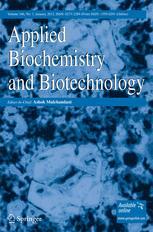Selective removal of enzymes from substrate and products. An alternative to immobilization for enzymes acting on macromolecular or solid substrates.
Dublin Core
Título
Selective removal of enzymes from substrate and products. An alternative to immobilization for enzymes acting on macromolecular or solid substrates.
Tema
ALFA-AMILASA
TRIPSINA
FOSFATASA ALCALINA
ENZIMAS
TIOSULFINATOS
ALMIDÓN
BIBLIOGRAFIA NACIONAL QUIMICA
1998
Abstract
A new approach for the control and interruption of enzymatic reactions via selective enzyme immobilization has been developed. The technique was exemplified by the use of three model enzymes with the corresponding macromolecular substrates: alpha-amylase/starch, trypsin/ insoluble collagen, and alkaline phosphatase/plasmid DNA. Prior to incubation with its substrate, each enzyme was provided with de novo thiol-groups by a two-step reaction involving N-succinimidyl-3-(2-pyridyldithio) propionate (SPDP) and DTT. The chemical modification was achieved such that at least 80% of the native enzyme activity was preserved in all cases. In order to interrupt rapidly the reactions in which the enzymes were used, the modified enzyme was immobilized by reaction via its thiol groups on a thiolsulfinate-agarose derivative. The gel-bound enzyme could then be easily removed from unreacted substrate and product by filtration or centrifugation. Comparative studies showed that the immobilized enzymes had much lower activities in the reactions studied than the corresponding soluble ones. The potential for enzyme reuse was also demonstrated with the alpha-amylase derivatives, which were quantitatively released and eluted in fully active form from the agarose. We have shown that it is possible to achieve practically complete enzyme immobilization in short times and thus to control the progress of the reactions. Because of its simplicity and high efficiency, this approach may represent an interesting alternative for biotechnological processes involving macromolecular or solid substrates
Fuente
Applied Biochemistry and Biotecnology v. 75, , 1998. -- p. 323-341
Editor
Springer
Fecha
1998
Derechos
Información sobre Derechos de Autor
(Por favor lea este aviso antes de abrir los documentos u objetos)
La legislación uruguaya protege el derecho de autor sobre toda creación literaria, científica o artística, tanto en lo que tiene que ver con sus derechos morales, como en lo referente a los derechos patrimoniales con sujeción a lo establecido por el derecho común y las siguientes leyes
(LEY 9.739 DE 17 DE DICIEMBRE DE 1937 SOBRE PROPIEDAD LITERARIA Y ARTISTICA CON LAS MODIFICACIONES INTRODUCIDAS POR LA LEY DE DERECHO DE AUTOR Y DERECHOS CONEXOS No. 17.616 DE 10 DE ENERO DE 2003, LEY 17.805 DE 26 DE AGOSTO DE 2004, LEY 18.046 DE 24 DE OCTUBRE DE 2006 LEY 18.046 DE 24 DE OCTUBRE DE 2006)
ADVERTENCIA - La consulta de este documento queda condicionada a la aceptación de las siguientes condiciones de uso: Este documento es únicamente para usos privados enmarcados en actividades de investigación y docencia. No se autoriza su reproducción con fines de lucro. Esta reserva de derechos afecta tanto los datos del documento como a sus contenidos. En la utilización o cita de partes debe indicarse el nombre de la persona autora.Formato
PDF
Idioma
Inglés
Tipo
Artículo
Identificador
doi: 10.1007/BF02787784
Document Item Type Metadata
Original Format
PDF
- Fecha de agregación
- August 5, 2015
- Colección
- Bibliografía Nacional Química
- Tipo de Elemento
- Document
- Etiquetas
- Alfa-amilasa, Almidon, Enzimas, Fosfatasa alcalina, Tiosulfinatos, Tripsina
- Citación
- Brena, Beatriz M, “Selective removal of enzymes from substrate and products. An alternative to immobilization for enzymes acting on macromolecular or solid substrates.,” RIQUIM - Repositorio Institucional de la Facultad de Química - UdelaR, accessed July 26, 2024, https://riquim.fq.edu.uy/items/show/3336.
- Archivos

